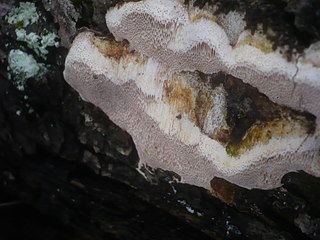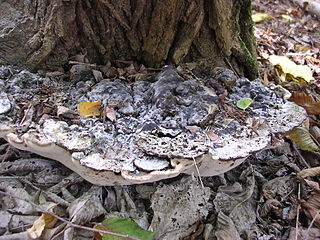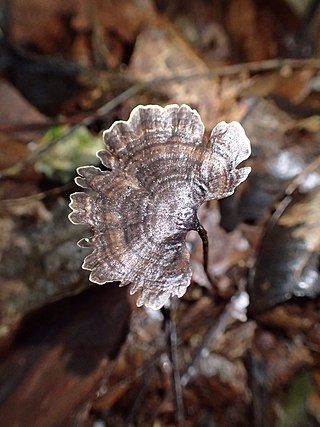
The Polyporaceae are a family of poroid fungi belonging to the Basidiomycota. The flesh of their fruit bodies varies from soft to very tough. Most members of this family have their hymenium in vertical pores on the underside of the caps, but some of them have gills or gill-like structures. Many species are brackets, but others have a definite stipe – for example, Polyporus badius.
Xeromphalina fraxinophila is a species of fungus in the family Mycenaceae. It is a plant pathogen.

Perenniporia subacida is a species of poroid fungus in the family Polyporaceae. It is a plant pathogen that infects Douglas firs. The fungus was originally described in 1885 by American mycologist Charles Horton Peck. Marinus Anton Donk transferred it to the genus Perenniporia in 1967. The four varieties of this fungus originally proposed by Peck, namely Polyporus subacidus var. stalactiticus, P. subacidus var. tenuis, P. subacidus var. tuberculosus and P. subacidus var. vesiculosus, have been shown to be synonyms. The species is inedible.
Abundisporus quercicola is a species of bracket fungus that grows on living oaks in temperate forests in the foothills of the Himalaya. The fruit bodies are perennial, grey to black above with concentric markings and white below. The fungus grows to 7 cm wide and 5 cm thick, projecting up to 5 cm from the substrate. The basidiospores are yellow.

Perenniporia is a cosmopolitan genus of bracket-forming or crust-like polypores in the family Polyporaceae. They are dimitic or trimitic with smooth, thick-walled basidiospores and cause a white rot in affected wood.
Perenniporia piceicola is a species of poroid crust fungus that is found on fallen spruce in Yunnan province, China. Basidiocarps are corky in texture, 5 cm (2 in) or more across with a characteristic pale yellow pore surface. The basidiospores are ellipsoid and hyaline and very large for the genus, up to 13 μm in length.
Perenniporia podocarpi is a species of resupinate (encrusting) polypore. It occurs widely but uncommonly on the New Zealand endemic podocarps Dacrydium cupressinum and Prumnopitys taxifolia. Basidiocarps are dimitic and grow up to 9 cm across, thick and cushion-like with a distinctive white or very pale cream spore surface with large pores. The basidiospores are extremely large for the genus, up to 27 μm in length.

Perenniporia medulla-panis is a species of poroid fungus in the family Polyporaceae. It is a plant pathogen that infects stone fruit trees. The species was first described by Nikolaus Joseph von Jacquin in 1778. Marinus Anton Donk transferred it to the genus Perenniporia in 1967.

Perenniporia fraxinea is a species of poroid fungus in the family Polyporaceae. It is a plant pathogen infecting ash trees.
Navisporus is a genus of seven species of tropical poroid fungi in the family Polyporaceae. It was circumscribed by Norwegian mycologist Leif Ryvarden in 1980 with Navisporus floccosus as the type species. This fungus, first described as Trametes floccosa by Giacomo Bresadola in 1896, is thought to have been originally collected in Tanzania.
Pseudopiptoporus is a genus of fungi in the family Polyporaceae. It was circumscribed by Norwegian mycologist Leif Ryvarden in 1980 with the type species Pseudopiptoporus devians. This fungus was originally published as Polyporus devians by Giacomo Bresadola in 1920. Pseudopiptoporus chocolatus was added to the genus in 2003.
Perenniporia nanlingensis is a poroid fungus first isolated from Guangdong Province, China. It has crust-like fruit bodies with a pinkish pore surface when in dry condition. Microscopically, it has a trimitic hyphal system, a slightly dextrinoid and binding hyphae. Its basidiospores are ellipsoid, truncate, and measure 9.0–9.8 by 5.0–5.9 μm.
Perenniporiella is a genus of five species of polypore fungi in the family Polyporaceae. The genus was segregated from Perenniporia by Cony Decock and Leif Ryvarden in 2003 with P. neofulva as the type species.
Truncospora is a genus of 10 species of fungi in the family Polyporaceae.
Yuchengia is a fungal genus in the family Polyporaceae. It is a monotypic genus, containing the single species Yuchengia narymica, a crust fungus formerly placed in the genus Perenniporia and originally described as Trametes narymica by Czech mycologist Albert Pilát.
Perenniporia minor is a poroid fungus in the family Polyporaceae. It was described as a new species in 2008 by mycologists Yu-Cheng Dai and Hong-Xia Xiong. The type specimen was collected in Changbaishan Nature Reserve in Jilin province, where it was found growing on fallen angiosperm branches at an altitude of 1,100 metres (3,600 ft).
Perenniporia meridionalis is a poroid crust fungus in the family Polyporaceae. It was described as a new species by Cony Decock and Joost Stalpers in 2006. The holotype specimen was collected in the Province of Nuoro in Italy, where it was found growing on dead wood of Quercus ilex. Distinguishing characteristics of this fungus include its relatively large pores, the hyaline vegetative hyphae that are yellowish to slightly dextrinoid in Melzer's reagent, and large spores measuring 6.0–7.7 by 4.5–6.2 µm. P. meridionalis occurs in central and southern Europe, where it is found in warmer forested areas, usually on dead oak wood. It has also been reported to occur in North America.
Perenniporia puerensis is a poroid crust fungus in the family Polyporaceae. Found in Yunnan, China, it was described as a new species in 2017. The crust-like fruit body of the fungus have a yellow to ochraceous pore surface, with 4 to 6 pores per millimetre. P. puerensis has a dimitic hyphal system with non-dextrinoid and cyanophilous skeletal hyphae that are encrusted with pale-yellow crystals. The spores are egg-shaped to somewhat spherical, thick-walled, non-dextrinoid, and cyanophilous, with dimensions of 4.3–5.5 by 3.7–4.7 µm.

Perenniporia stipitata is a species of poroid fungus in the family Polyporaceae. Found in Brazil, it was described as a new species in 1987 by Norwegian mycologist Leif Ryvarden.





